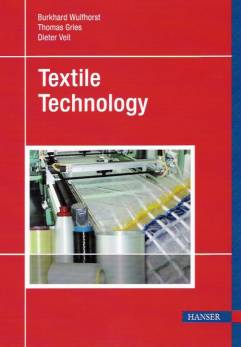|
|
|
Rezension
Mit „Textile Technology“ gelingt den Autoren ein Standardwerk der Textiltechnik in englischer Sprache. Dieses Buch bietet Auszubildenden, Studenten oder Mitarbeitern in der Textilwirtschaft Grundlagen der Textiltechnik von den Rohstoffen über die Garn- und Stoffproduktion und die Veredlungsprozesse bis hin zur Bekleidungsproduktion und zum Recycling. Auch die immer mehr an Bedeutung gewinnenden Technischen Textilien werden behandelt. Unterstützt wird der Text durch anschauliche Grafiken, Tabellen, Zeichnungen und Fotos, die auch z.B. Fachvokabular verdeutlichen sowie Arbeitsprozesse und Maschinen zum besseren Verständnis darstellen.
Da es sich hierbei um ein Fachbuch handelt, sind Kenntnisse des Fachenglischs aus dem Bereich Textil bei der Lektüre des Buches sehr zu empfehlen. Liegen diese Kenntnisse vor oder auch mit Hilfe eines Fachwörterbuches sind die Texte gut verständlich und anschaulich verfasst. Zudem ist das Buch sehr gut strukturiert und somit sehr übersichtlich gestaltet. Stichpunktartig werden aufgezählte Informationen, wie Vorteile und Abläufe bestimmter Verfahren, dargestellt und tragen so zur Übersichtlichkeit bei. Da auch im Bereich Textil die Sprache Englisch zur Kommunikation immer mehr an Bedeutung gewinnt, dient dieses Buch nicht nur zur Erlangung des nötigen Fachwissens für den Beruf, sondern fördert zugleich das (Fach-)Englisch des Lesers. Daher ist „Textile Technology“ nicht nur für Berufseinsteiger zu empfehlen, denn auch „Textil-Profis“ können hier ihren Englischwortschatz aufbessern. Carmen Kellmann für lbib.de Verlagsinfo
"Textile Technology" presents a well-written and readable introduction into the field of textile engineering. It is based on an elementary level course focusing on the manufacture (processes and machines) of yarn, fabric, knitwear, nonwovens, braids, reinforcing fabrics, and technical textiles. The book also provides the technicians and engineers in the textile industry with an up-to-date review of processes and equipment for textile manufacturing. The book covers all processing steps for the manufacturing of textiles, describing materials, processes and machines, finishing, making-up, and recycling. To provide a better understanding of the individual textile processes, each chapter ends with an example describing the respective processing steps for a specific textile product. In addition, current and future development trends are discussed. Contents: - Raw Materials - Yarn Production - Fabric Production - Knitwear Production - Nonwovens Production - Braiding Processes and Machines - Production of Two-dimensional Reinforcing Fabrics - Textile Finishing - Processes and Machines for Making-up - Technical Textiles - Disposal and Recycling of Textiles Inhaltsverzeichnis
1 Introduction
1.1 Evolution of Textile Technology 1.2 Importance of the Textile Industry 1.3 Manufacturing Steps 1.4 Textile Products 1.5 References 2 Raw Materials 2.1 Natural Fibers 2.1.1 Plant-Derived Fibers 2.1.2 Animal Fibers 2.1.3 Mineral Fibers 2.2 Chemical Fibers 2.2.1 Manufacturing Processes 2.2.2 Chemical Fibers from Natural Polymers 2.2.3 Chemical Fibers from Synthetic Polymers 2.2.4 Chemical Fibers from Inorganic Raw Materials 2.2.5 Further Processing 2.3 Examples 2.4 References 3 Principles and Machinery for Yarn Production 3.1 Cotton Spinning 3.1.1 Spinning Preparation Machines 3.1.2 Combing Room 3.1.3 Ring Spinning Process 3.1.4 Nonconventional Spinning Principles 3.2 Worsted Yarn Spinning 3.3 Mock-Worsted Spinning 3.4 Carded Woolen Spinning 3.5 Development Trends 3.6 Fineness Measurements of Fibers and Yarns 3.7 Summary of the Measurement Systems 3.8 Examples 3.9 References 4 Principles and Machinery for Production of Woven Fabrics 4.1 Production Principles 4.2 Preparation for Weaving 4.2.1 Winding 4.2.2 Twisting 4.2.3 Preparation of the Warp Beam 4.2.4 Warping 4.2.5 Section Warping 4.2.6 Sizing 4.3 Construction of Woven Fabrics 4.3.1 Basic Weave Patterns 4.3.2 Special Weaving Techniques 4.4 Design and Principle of Weaving Looms 4.5 Development Trends 4.6 Examples 4.7 References 5 Processes and Machines for Knitwear Production 5.1 Stitch Formation 5.2 Machines for Stitch Formation 5.2.1 Knitting Machines 5.2.2 Warp-Knitting Machines 5.3 Development Trends 5.4 Examples 5.5 References 6 Processes andMachines for Nonwoven Production 6.1 Processes and Machines 6.1.1 Processes of Web Formation 6.1.2 Web Bonding Processes 6.1.3 Finishing 6.2 Applications 6.3 Development Trends 6.4 Examples 6.5 References 7 Braiding Processes and Machines 7.1 Braiding Process 7.1.1 Conventional Braiding Processes 7.1.2 Process for the Production of 3D Braids 7.2 Division of Braids 7.3 Development Trends 7.4 References 8 Processes and Machines for the Production of Two-Dimensional Reinforcing Fabrics with Multiaxial Construction 8.1 Warp-Knitted Multiaxial Fabrics (MAG) 8.1.1 FromWarp-Knitted Fabrics to MAG 8.1.2 Production and Characteristics of MAG 8.1.3 Unconventional Use of the LIBA Technology 8.2 Malimo Stitch Bonding Technology 8.2.1 The Stitch Warp-Knitted Fabric 8.2.2 Multiaxial Stitch Bonded Fabrics 8.2.3 Variable Stitch Bonded Multi-Ply Fabrics (NVG) 8.3 Development Trends 8.4 References 9 Processes and Machines for Textile Finishing 9.1 Pretreatment 9.1.1 Dry Pretreatment 9.1.2 Wet Pretreatment 9.1.3 Fiber-Specific Processes 9.2 Drying 9.3 Coloration 9.3.1 Dyeing 9.3.2 Printing 9.4 Appret 9.4.1 Chemical Appret 9.4.2 Mechanical Finishing 9.4.3 Thermal Finishing 9.5 Coating 9.6 Development Trends 9.7 Examples 9.8 References 10 Processes and Machines for Clothing Manufacture 10.1 Separation 10.2 Processes of Joining 10.2.1 Sewing 10.2.2 Bonding and Setting 10.2.3 Welding 10.3 Forming 10.4 Automation 10.5 Development Trends 10.6 Examples 10.7 References 11 Technical Textiles 11.1 Definitions of Technical Textiles 11.2 Examples of Technical Textiles 11.2.1 Fiber-Reinforced Material 11.2.2 Protective Textiles (Mobiltech, Protech) 11.2.3 Textiles for Civil Engineering (Buildtech) 11.2.4 Geotextiles (Geotech) 11.2.5 Medical Textiles (Medtech) 11.3 Development Trends 11.4 References 12 Disposal and Recycling of Textiles 12.1 Circulation of Material in the Textile Industry 12.1.1 Life Cycle of a Product 12.1.2 “Kreislaufwirtschafts- und Abfallgesetz” (Economic Cycle and Waste Law) 12.2 Examples of Recycling 12.2.1 Production Waste 12.2.2 Apparel 12.2.3 Carpeting 12.2.4 Automobile Textiles 12.2.5 Processing and Treatment of Reprocessed Fibers 12.3 Development Trends 12.4 Examples 12.4.1 Jeans 12.4.2 Carpets 12.4.3 Airbags 12.5 References Index |

 Bei Amazon kaufen
Bei Amazon kaufen